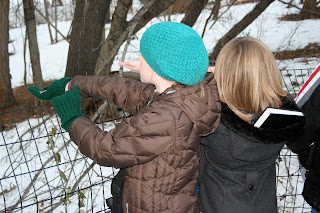It was a chilly day, but the sun was out in full glow. So I headed out of Brooklyn for the afternoon, and visited Bear Mountain--about an hour and a half north of the city. In the summer, Bear Mountain is teeming with visitors, but the frigid temperatures only bring out the real nature lovers....like me! Visited the Trailside Museum and Zoo (suggested donation only $1!) and saw some fantastic owls, a tremendous eagle, a prickly porcupine, a curious possum, some gorgeous snakes and frogs, and even some Eastern coyote. Most of the animals here are either injured or orphaned. All the animals are stationed along a trail that has some very informative nature signs. Even Ms. Seitz learned a thing or two, like maple syrup can be made from Red Maples (but it doesn't taste as good as syrup made from Sugar Maples.)
 Remember, it might be cold, but step out into nature anyway....either by exploring the woods in Prospect Park or another city park, or by venturing a bit out of the city for a new lens on the great out of doors! Happy trails!
Remember, it might be cold, but step out into nature anyway....either by exploring the woods in Prospect Park or another city park, or by venturing a bit out of the city for a new lens on the great out of doors! Happy trails!































